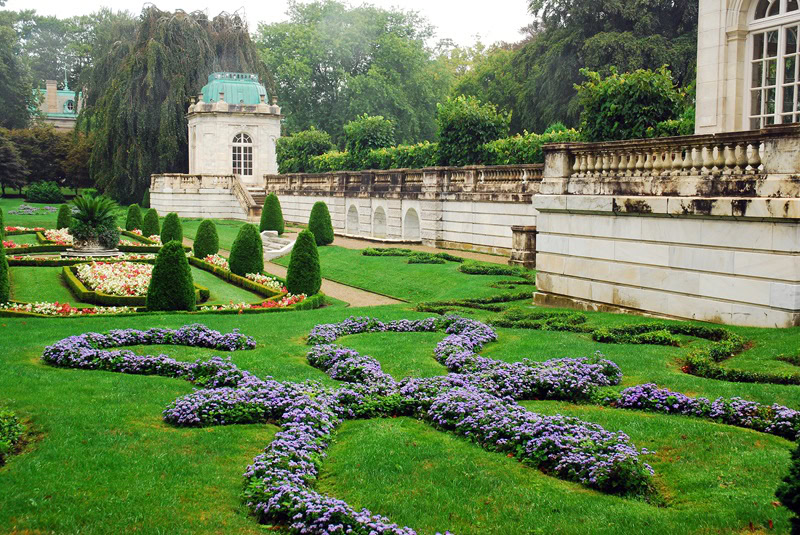Set along Newport’s iconic Bellevue Avenue, The Elms is one of the most celebrated Gilded Age mansions in Rhode Island.
Built as a summer retreat for coal magnate Edward Julius Berwind and his family, the palatial estate was inspired by a famed 18th-century French château and designed to showcase European grandeur on American soil.
Like many of the opulent “summer cottages” that line Newport’s cliffs, The Elms harks back to an era when the wealthiest families in America built monumental homes to entertain their many guests and escape the summer heat of the city.
Today, The Elms is a key part of Newport’s architectural heritage and a timeless symbol of America’s Gilded Age splendor. Let’s take a closer look at this historic mansion.
Get your property news in real time: Follow us on Google News
Construction began in 1899 and cost around $1.5 million (over $50 million today)

Edward Berwind spared no expense when commissioning The Elms. Designed by Philadelphia architect Horace Trumbauer, the mansion took nearly two years to complete, with construction wrapping up in 1901.
Its price tag of $1.5 million may seem modest by modern standards, but in today’s dollars, it equates to over $50 million.
Modeled after a well-known French castle

Trumbauer modeled The Elms after the Château d’Asnières near Paris — which in itself was in part inspired by the Grand Trianon in Versailles — blending European refinement with the cutting-edge American technology of the time. And the resemblance to its French counterpart really is striking.
A showcase of Beaux-Arts architecture

The Elms is one of the finest examples of Beaux-Arts architecture in the United States.
The style, known for its symmetry, classical details, and grandeur, is on full display here. The mansion features soaring ceilings, intricate moldings, and a façade adorned with classical sculptures.
A garden paradise designed for entertaining

The estate’s manicured gardens are almost as famous as the mansion itself. Edward Berwind hired landscape designer Ernest Bowditch to create formal gardens inspired by French estates.
The grounds include marble fountains, sculptures, and a sunken garden that provide the perfect backdrop for hosting lavish parties.
Inside, a marble staircase steals the show

The centerpiece of The Elms is its grand marble staircase, which rises dramatically in the central hall. Modeled after European palaces, the staircase is flanked by bronze statues and illuminated by a massive skylight, creating a sense of grandeur as soon as you step inside.
A dining room fit for royalty

At the heart of the mansion lies the grand dining room, a space designed to impress. Lined with oak paneling and adorned with elaborate carvings, the dining room is anchored by a massive fireplace and opulent crystal chandeliers.
The Berwinds used this space to host elaborate dinners, entertaining some of the most influential figures of their time.
The conservatory is another standout space

One of the most unique rooms in The Elms is the glass-enclosed conservatory. Filled with exotic plants and flooded with natural light, this space likely served as a retreat where the Berwinds could enjoy nature without leaving the comfort of their mansion.
The mansion has 48 rooms spread across four levels

While its exterior suggests a more compact design compared to other Gilded Age mansions, The Elms boasts 48 rooms, including eight luxurious bedrooms, a grand ballroom (pictured here), a library, and servant quarters.
The layout reflects the Berwinds’ dual priorities: creating spaces for entertaining and ensuring their servants could efficiently run the estate.
Modern technology ahead of its time

This particular French chateau wasn’t just about old-world elegance — it also featured cutting-edge technology for its time. It had one of the first electric dumbwaiters, a central heating system, and a state-of-the-art icebox to preserve food, which was groundbreaking for the early 1900s.
Saved from demolition in the 1960s

By the mid-20th century, many Newport mansions faced the threat of being demolished due to high maintenance costs. The Elms was no exception.
In 1962, just weeks before the mansion was planned to be torn down and turned into a parking lot, the Preservation Society of Newport County purchased the estate for $116,000, saving it from the wrecking ball.
Added to the National Register of Historic Places in 1971

The Elms earned its place on the National Register of Historic Places in 1971, cementing its status as a historic treasure. It has since been meticulously restored, with efforts to preserve its interiors and gardens, allowing visitors to experience the Gilded Age as it was meant to be seen.
Now a popular tourist attraction

Today, The Elms is open to the public as part of the Preservation Society’s efforts to showcase Newport’s Gilded Age heritage.
Visitors can explore its rooms, marvel at its architecture, and stroll through its gardens. It’s a must-see for anyone visiting Newport and a reminder of a time when elegance and extravagance reigned supreme.
The Elms in pop culture

While not as frequently featured in movies as The Breakers or Marble House, The Elms has served as a backdrop for documentaries and period dramas, offering a glimpse into the world of the wealthy elite of the early 20th century.
It was featured in Newport Mansions: The Gilded Age’s Grandeur on PBS and appeared in America’s Castles, which highlighted its French-inspired architecture and lavish interiors. Period dramas like Julian Fellowes’ The Gilded Age also used the mansion as a filming location.
More stories
The Marble House in Newport, Rhode Island: the Gilded Age mansion that started it all
Historic Rhode Island farm with deep ties to the Vanderbilts heads to auction
The story of Taylor Swift’s Holiday House in Rhode Island — Home to “the Last Great American Dynasty”


